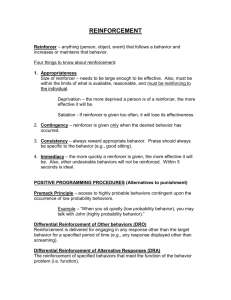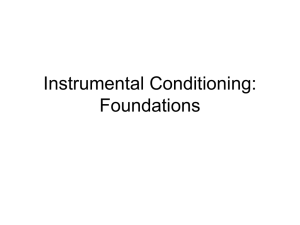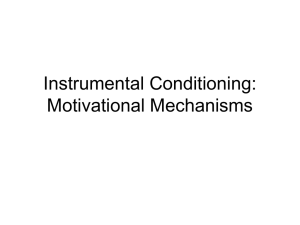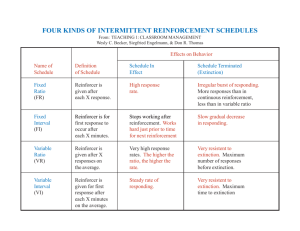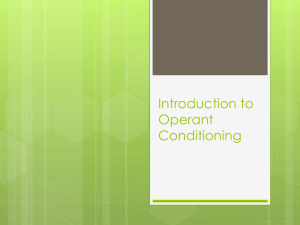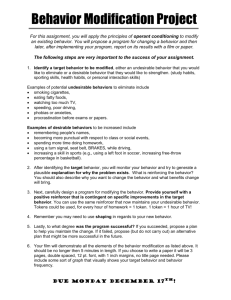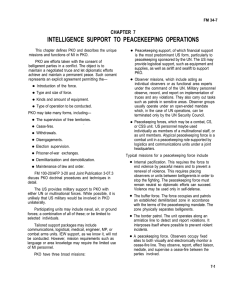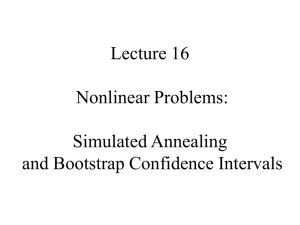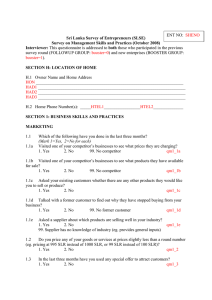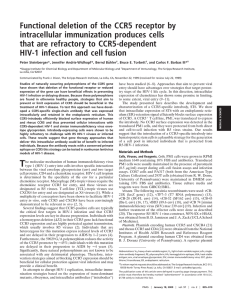lecture 14
advertisement
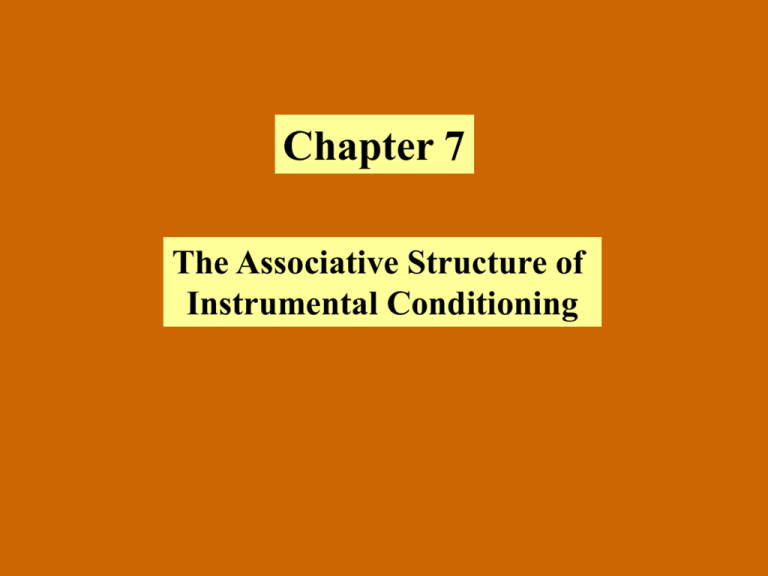
Chapter 7 The Associative Structure of Instrumental Conditioning The way we talk about Pavlovian conditioning is very ‘cognitive’ we say that animals form mental representations of the relationships among stimuli animal has a representation of the CS that gets associated with some representation of the US when we present a CS, it calls up a representation of the US Instrumental/operant conditioning is now viewed in the same way subjects/animals are information-processors, not only with respect to stimuli (Pavlovian) but also with respect to their own behavior (operant) 3 main components in operant learning situation 1. Stimulus – S (or sometimes Sd) the discriminative stimulus sets the occasion for reward by signaling when the response will be followed by the reinforcer 2. Response – R 3. Outcome – O Associations develop among each of these elements: S-R association the discriminative stimulus can become directly associated with the response S-O association the discriminative stimulus can become associated with the outcome (basically a Pavlovian association) R-O association the response becomes associated with the outcome In recent years, this notion that animals develop mental representations of behavior is probably best shown in the work of Rescorla Rescorla and colleagues have done a # of experiments demonstrating that animals develop R-O associations The typical way to demonstrate R-O association is to train rats to make a response for a particular outcome and then devalue that outcome — should lead to a decrease in responding R-O association Colwill & Rescorla (1985) Training Devaluation R1 LP O1 Sucrose O1 LiCL O2 nothing R2 CP O2 food (Same rats get both) Test R1 and R2 Everything is counterbalanced, but for the sake of simplicity say LP = sucrose and CP = food and the sucrose is devalued R-O association animals should have developed 2 different R-O associations during test, 20 min with both responses available they could LP or CP but no outcome was given, i.e., essentially an extinction test if R1 evokes memory for devalued or aversive outcome, but R2 does not, then should see a decrease in R1 R-O association Results: 7 6 R2 -outcome not devalued 5 Mean resp/min 4 3 2 R1 -outcome was devalued 1 Time R-O association Results: when outcome (reinforcer) was devalued by pairings with LiCl, the response that produced the reinforcer declined the reason is that subjects remembered the reinforcer as being aversive and therefore devalued the response that was associated with that outcome so, memory for, or representation of, the goal object is crucial for the execution of the response S-O association Like Pavlovian CSs, Sd (discriminative stimuli) also become associated with outcomes Colwill & Rescorla (1988) Sd training Response training Test S1 R1 O1 R3 O1 S1: R3 vs R4 N LP Suc R4 O2 S2: R3 vs R4 S2 R2 O2 L CP food 2 new responses All rats get both S-O association if rat has S-O association (i.e., knew which outcome went with which Sd), then when given S1 on test, should perform the response that was associated with the same outcome i.e., when given S1 — should perform R3 S2 — should perform R4 This is essentially what happened S-O association Results: 10 Same outcome 8 Mean 6 resp/min Different outcome 4 2 Trials S-O association Results: in the presence of a particular Sd, the rats performed the response that was associated with the same outcome, more than the response associated with the different outcome evidence for S-O association S-R association somewhat simpler to demonstrate T BP food see more BP during the T than in its absence Rescorla has shown with devaluation experiments that even with complete devaluation, see some responding due to S-R association for ex., devalue food in the presence of the T, rat still barpresses (but won’t eat the food) Hierarchical Associations In addition to the simple associations of 2 elements (i.e., S-R, S-O, R-O), can also have hierarchical associations the Sd becomes an occasion setter that signals when the response will be followed by a reinforcer S R R O nothing so, the Sd signals the relationship between a response and its outcome S [R O] Hierarchical Associations Recall from Pavlovian conditioning that a CS is only powerful when it reliably predicts a US When the CS provides no reliable information about the occurrence of the US, then conditioning is weak The same idea has been applied to the learning of a hierarchical association Hierarchical Associations S R R O nothing In this situation, the S is informative about when the R will be followed by the O S R R O O However, in the second situation, the S is provides no information about when the R will be followed by the O Hierarchical Associations Rescorla (1990) used this idea to obtain evidence for a hierarchical association Training Test S1 [R1 O1] S1: R1 vs R2 S1 [R2 O2] S2: R1 vs R2 S2 [R1 O2] S2 [R2 O1] 4 30-s presentations of both discriminative stimuli, with both responses available But also, R1 R2 O1 O2 Which Sd is informative about the R-O relation??? Hierarchical Associations Results: 7 S2 - informative 6 5 Mean resp/min 4 3 S1 -not informative 2 1 Trials Theories of Reinforcement 1. Reinforcement as stimulus presentation What identifies a reinforcer? Thorndike a stimulus that is satisfying the problem with this definition is that it is circular Theories of Reinforcement Hull’s Drive Reduction Theory a biological need upsets the body’s homeostasis and induces a drive state any stimulus that satisfies the biological need, restores homeostasis, and thus reduces the drive state serves as a reinforcer the problem with this definition is that many reinforcers do not restore/maintain homeostasis incentive motivation (response elicited by reinforcer), curiosity, praise, criticism Theories of Reinforcement 2. Reinforcement as behavior A. The Premack Principle rather than talking about reinforcing stimuli, Premack focused on reinforcing responses so, instead of saying food is a reinforcing stimulus, Premack said eating is a reinforcing response the only difference between an operant response and a reinforcer is the probability of occurrence avoided circularity by defining a reinforcer as a more probable behavior than the ‘operant’ behavior that is, high probability behaviors will reinforce low probability behaviors, but not the reverse When a rat is water deprived (E1), it drinks more than it runs. Therefore, drinking reinforces running, but running does not reinforce drinking. When a rat is not water deprived (E2), it runs more than it drinks. Then running reinforces drinking, but drinking does not reinforce running Theories of Reinforcement B. Behavioral Regulation Approaches expanded on Premack Principle took into account the animal’s repertoire of behavior in a context this established the “bliss point”, the optimum distribution of responding for the subject operant contingencies shift the subject away from the bliss point; the subject behaves so as to approach the optimum distribution as closely as possible Time Studying

